Elephant with Howdah

Needle Case (photographs courtesy of Lynda Herrod)
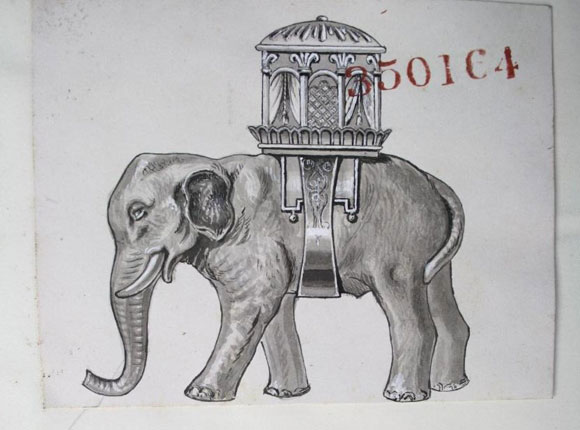
Design Representation
Design Details
Needle Case Type: |
Figural (not listed on design representation as a needle case) |
Patent/Registered to: |
W. Avery & Son - Birmingham
Note: Avery's address is listed as 19 Hall Street in Birmingham which is the same address as J. M Farnol. |
Patent/Design Representation #: |
Ornamental Class1: Metal: #350164 |
Patent/Design Registration Date: |
May 27, 1880 |
Location of Patent/Design Registration: |
The National Archives (TNA) - Kew, UK |
Reference #: |
TNA Representation - BT 43/46/350164
TNA Register - BT 44/4/350164 |
Dimensions: |
10 x 3 x 9 |
Material: |
Brass |
Name Variations: |
W. Avery & Son - Redditch |
Other Variations: |
None |
Additional Photographs

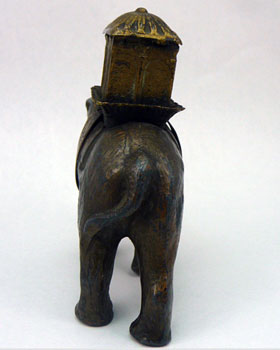
Side and back views
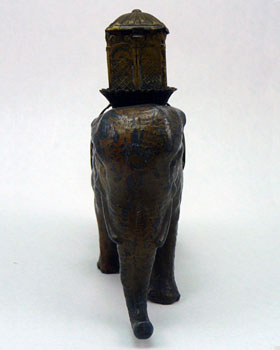
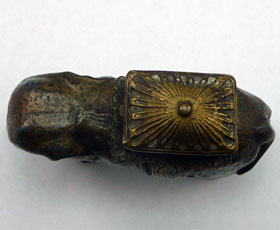
Front and top views
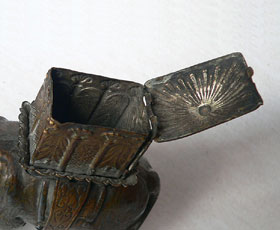
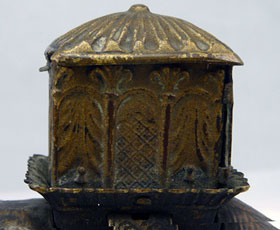
Howdah open and howdah detail
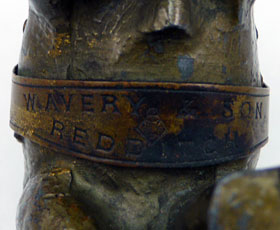
Bottom signature detail
Facts
The elephant, the largest land dwelling mammal, is regarded as very intelligent. The African elephant is larger than the Asian,
weighing up to 8 tons. The two types can be distinguished by their ear shape, Asian having smaller, straight bottomed ears while
African are large and fan shaped. Their life span can be 70 years. Males tend to be solitary but females and calves live in
matriarchal family groups with deep family bonds. Calves which stay close to their mothers for around 8 years are also cared for
by other females. Elephants are known to display signs of grief, joy, anger and play. With each adult eating 300-400 pounds
of food a day herds need extensive land to survive. Once plentiful throughout Africa and Asia, due to the trade in ivory numbers
dwindled during the 20th century. Although the Convention on International Trade in Endangered Species of Fauna and Flora (CITES)
has attempted to close down illegal trade in elephant ivory, poaching remains a major problem. Habitat destruction and loss of their
migratory routes pose another major threat due to competition from humans for resources.

History
Elephants have been tamed and used as beasts of burden for more than 4000 years. Asian elephants which have a more cooperative
nature have been used for log hauling and crop transport as well as military roles. War elephants were commonly employed to carry
troops or charge in battle to trample and terrorise the enemy. Their use spread from India across south–east Asia where they were
used up until the late 19th century by Siamese and Vietnamese armies. Use of war elephants also spread to Europe probably best
known in relation to Pyrrhus, Hannibal and Alexander the Great. As well as carrying troops the carriage on an elephant’s back
or howdah was used for hunting or carrying wealthy people. In the latter case this carriage would be highly decorated to show the
owner’s wealth. Children’s rides were once also provided on elephants by zoos.
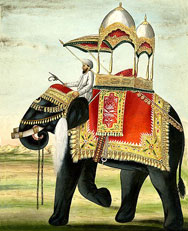
Miscellaneous
The term white elephant, a valuable object that has little use compared to the cost or convenience of upkeep, is reputed to come from the
practice of the kings of Siam who would make a gift of a sacred white elephant to someone they considered a threat to their power or who had
otherwise displeased them. The cost to the recipient who was obliged to keep the animal would be ruinous.
The Great Exhibition at the Crystal Palace in 1851 included in the Indian display a magnificent howdah and drapes which posed a problem
for the organisers until they were able to source a stuffed elephant from a museum to properly show the exhibit. Unfortunately the
elephant’s ears indicated that it was not Asian but an African elephant.
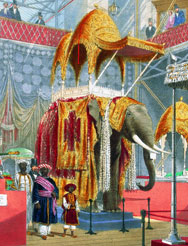
Note: Right side panel text provided by Lynda Herrod.
















